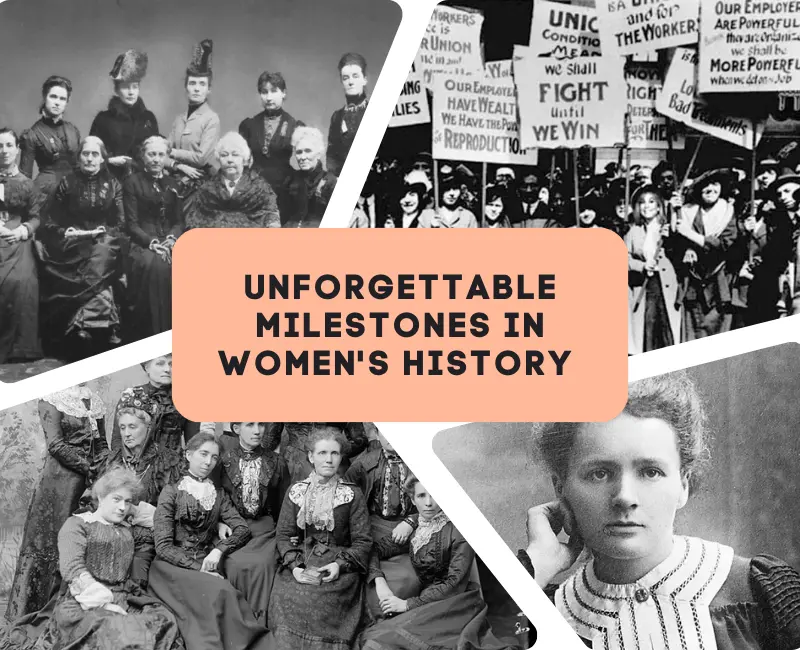Unforgettable Milestones in Women’s History

In a society where male dominance and patriarchy are deep-rooted, women had to earn their positions and rights to attain the same level of equality as men. Today, women enjoy various rights and opportunities they have always deserved, a testament to the progress made in women’s rights. There are numerous trailblazers to thank who have played a significant role in initiating the process of growth, inclusion and equality for women. Global women’s history is full of fights for equality, breaking stereotypes and achieving great things, making the impossible possible, challenging the system, and fighting injustice against women. In this blog, we will explore the most unforgettable milestones in women’s history that have revolutionized women’s world.
Seneca Falls Conventions (1848) & the 19th Amendment Act (1920)
Seneca Falls Convention is the first women’s rights convention in the history of women in the USA. Held on 19th and 20th July 1848 in New York, this convention allowed the gathering of women only on the first day and entry open to men on the second day, with around 300 attendees. The convention was organized by five women activists: Elizabeth Cady Stanton, Lucretia Mott, Mary M’Clintock, Martha Coffin Wright and Jane Hunt; they were also a part of the abolitionist movement to end slavery and racism. The convention was held to protest the government and demand women’s rights to freedom and equality, as well as the women’s suffrage movement. The head of the convention, Elizabeth Cady Stanton, proposed the Declaration of Sentiments that demanded various women’s rights, including the right to equality, stating women must have equal rights to life, pursuit of happiness, property and earnings as men, right to education that meant equal educational and academic opportunities and right to equal employment opportunities; right to have custody of children in a divorce or death of spouse, legal rights that included right to be free from laws made by men and legal status. One of this draft’s most prominent and controversial demands was the right to vote (women’s suffrage). 11 out of 12 resolutions were passed unanimously, excluding the ninth one, i.e., women’s right to vote. Nonetheless, it is considered the cornerstone of the women’s suffrage movement; after 70 years of this convention, the 19th Amendment Act was approved in 1920, stating that all American citizens, regardless of gender, cannot be denied the right to vote.
South Australia granting the right to vote to women and stand for elections (1895)
South Australia granted the women the right to vote and stand in parliament in elections. The women suffrage league founded by Mary Lee and Mary Colton had signed the petition for this with more than 11,600 signatures across the colony. Education for women was supported prominently in South Australia since the beginning, this being a robust reason for supporting the right to vote for women as women were educated there. Women’s right to stand in elections was added in the bill with the motivation to prevent the bill from passing but surprisingly, the government passed the bill, giving not only the right to vote but also the right to stand in the parliament. Notably, New Zealand was the first country to allow women the right to vote but south Australia became the first country that allowed women to stand in parliament.
Female textile workers’ protest against working conditions in the garment industry
The first protest, a courageous act of defiance, was held in 1857 in New York. Women, facing sexual harassment, long working hours, and unfair wages, stood up for their rights. This bold protest led to the establishment of a women-only trade union in many American enterprises, a testament to the power of collective action.
Women workers, undeterred by the lack of improvement in their conditions, held another protest on 8th March 1908. Their demands were clear and just: shorter working hours, an end to child labour, and equal wages as men. This event, a significant milestone in the history of women’s rights and the fight against injustice, not only inspired the declaration of 28th February as National Women’s Day in 1909 by the socialist party but also set the date for International Women’s Day, a global celebration of women’s achievements and ongoing struggle, on 8th March every year.
First woman to win Nobel prize (1903)
Marie Curie is known for her work in the science field. She became the first woman to receive the Nobel prize for her research in radiation in 1903 with her husband, Pierre Curie and Henri Becquerel. She won the second Nobel Prize in 1911 for discovering two elements, radium and polonium. She named the element polonium after her birth country, Polland. Curie is the first person to win two Nobel prizes and the only person in the world to win Nobel prizes in two different scientific fields. i.e., physics and chemistry. Marie Curie paved the way for other women in science and academics and became a role model for many. This brilliant woman was the first woman to teach at the prestigious French University, Sorbonne. Her work in radioactivity led to the development of new treatments for cancer and X-rays in surgery, revolutionizing the field of medicine. She continues to be an inspiration for women worldwide.
Amelia Earhart- the first person to fly solo across the Atlantic (1932)
Amelia Earhart had impressive aviation records, becoming the first person to fly solo across the Atlantic Ocean in 1932. She was a woman’s rights advocate and co-founded Ninety-nines, an organization for female aviators which included around 5,000 women across 35 countries. She was the first president of the organization. Earhart was also a National Woman’s Party member, fighting for women’s right to vote and the Equal Rights Amendment. She was a feminist, a trailblazer and an expert in her field. She continues to be an inspiration for female aviators and women across the globe.
The woman’s army crops (1943)
During World War II, the USA needed more soldiers. Women served as nurses and were recruited into the Women’s Army Auxiliary Corps. In 1943, the government dropped the title ‘auxiliary’ and created the Women’s Army Corps (WAC). WAC was a significant development in women’s history, as it ensured equal rights and positions in the military for women. It was a major step towards gender equality in the armed forces. However, WAC was disbanded in 1978, and women were included in the regular army forces, marking another milestone in the history of women in the military.
Rosa Park raising her voice against racism (1955)
Known as the ‘mother of the civil rights movement’, Rosa Park is a beacon of courage in women’s history. On December 1st, 1955, Rosa, with unwavering bravery, refused to give up her seat to a white man on a bus in Montgomery, Alabama, becoming a potent symbol of the civil rights movement. Her arrest for this act of defiance sparked a significant boycott of buses in Montgomery, causing the bus company to face a considerable loss. Her courage inspired people of colour and all women, earning her numerous awards for her revolutionary act, such as the Presidential Medal of Freedom, the NAACP’s Spingarn Medal and the Congressional Gold Medal.
Equal Pay Act (1963)
On June 10th, 1963, the then-President of the USA, John F. Kennedy, signed the Equal Pay Act into law. The act stated that it is illegal to pay men and women differently for similar work. It was done to provide women with equal pay as men, instil equality, and defy gender discrimination. Hence, both genders must be paid equally for the same work. It was a significant moment in women’s history.
Valentina Tereshkova becomes the first woman to fly in space (1963)
Valentine Tereshkova, a Soviet cosmonaut and engineer, was a trailblazer in space exploration. She was the first woman to travel to space, boldly stating, “A bird cannot fly with one wing only. Human space flight cannot develop any further without the active participation of women.” On June 6th, 1963, she embarked on a solo mission on Vostok 6, orbiting the Earth 48 times and spending 3 days in space. Her pioneering spirit and achievements earned her various prestigious medals and a position as a World Peace Council member. Today, she serves as the Deputy Chair of the Committee for International Affairs in Russia.
Katie Bouman – mind behind creating the first image of blackhole (2019)
Katie Bouman is a computer scientist and professor who built an algorithm CHIRP (Continuous High-resolution Image Reconstruction using patch priors) that was able to filter everything from the blackhole and generate the image of it. She worked with over 200 scientists and collected data from all over the world using a network of 8 telescopes known as Event Horizon Telescope (EHT). Bouman was awarded the Electronic Imaging Scientist of the year award and co-awarded the Breakthrough prize in fundamental physics. She is a role model for women in computer science, physics and astronomy.
Conclusion
Women are equal counterparts in society but were denied the right to equality until revolutionary, courageous women and supportive men joined hands to raise their voices against unjust rules. Women excelled in stereotypically male-dominated fields and paved a path for others to follow, opening doors of opportunities for millions and proving that women are no less. Even today, in many places, women are not given equal rights, or people don’t seem to follow the rules of equality because of their narrow mindsets. We need a lot to achieve in the field of equality. However, women are thriving in numerous fields today, in various niches, underscoring the significance of the world-changing events in women’s history. It’s crucial that we continue to raise awareness and take action to ensure that women’s rights are upheld, and equality is achieved.


